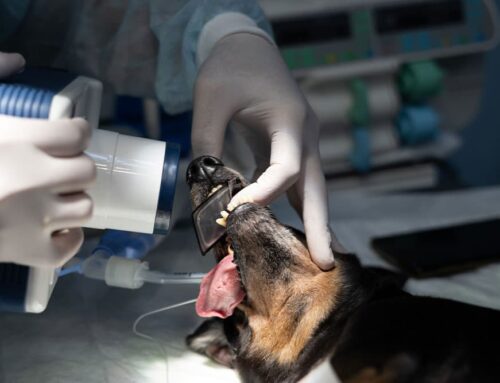Watching our pets age can be emotionally challenging. In the blink of an eye, their graceful steps seem to become stiff and labored, the bright eyes that once reflected so much love are clouded and opaque, and the sound of their name or a chip bag opening no longer seems to register.
Along with their senses and joints, some senior pets experience similar age-related changes in cognition or the brain, resulting in a dementia-like disorder. Here’s what you need to know about how to recognize cognitive dysfunction syndrome (CDS) and how to help your pet cope with their changing world.
What is cognitive dysfunction syndrome in pets?
CDS is a neurobehavioral condition in geriatric dogs and cats caused by age-related oxidative brain damage. The condition closely resembles Alzheimer’s disease in its pathology (i.e., body changes) and visible signs (i.e., behaviors). In addition to typical age-related brain changes, such as decreased mass, white matter, and number of neurotransmitters, CDS and Alzheimer’s patients have abnormal plaque deposits (i.e., b-amyloid plaques) in their brain tissue and vessels.
What are the CDS risk factors in pets?
Although canine CDS is more commonly reported, cats are equally susceptible. Dogs may begin experiencing learning and memory deficits after 7 years of age, although more noticeable CDS signs typically appear between ages 11 to 16 years. Cats may demonstrate age-related decline, although obvious changes are more apparent in geriatric cats older than 15.
Because CDS signs are easy to dismiss as normal aging, pet owners should be alert for any unusual behavior changes.
What does CDS look like in pets?
CDS can manifest in a collection of different signs that are normally grouped together under the acronym DISHAAL. These signs include:
- Disorientation — Pets appear confused in familiar environments and may become lost or disoriented in their home, such as standing at the wrong side of a door, getting stuck behind furniture, or failing to recognize familiar people.
- Interactions — Pets may be more anxious, fearful, or aggressive around people and other pets and may stop seeking attention.
- Sleep/wake disturbance — Pets may sleep more during the day and become active and restless at night.
- House soiling — Previously trained pets may have urine or stool accidents, often right outside the litter box or immediately after returning indoors.
- Activity — Pets may no longer show interest in previously enjoyable activities (e.g., toy play, leash walks, petting) or may show increased restlessness and repetitive behaviors, such as pacing, circling, chewing, or staring off into space.
- Anxiety — Formerly confident or independent pets may become clingy and attention-seeking, and may be nervous in unfamiliar places.
- Learning or memory changes — Pets may forget well-known commands or have difficulty learning new ones.

How is CDS diagnosed in pets?
Unfortunately, no CDS test is available, and diagnosis can only be confirmed by a post-mortem brain examination. As such, CDS is a diagnosis of exclusion—meaning that the condition is presumed only after medical causes for your pet’s behavior are ruled out. This process includes a thorough review of your pet’s behavior at home, as well as a physical examination and diagnostic testing (e.g., blood work, urinalysis, perhaps imaging).
However, because senior pets often suffer from multiple conditions (e.g., vision changes, hearing loss, painful arthritis, chronic disease), assuming that CDS is present and providing supportive care is often easier.
Is CDS a curable condition in pets?
Like Alzheimer’s disease, CDS is a progressive and degenerative condition with no known cure—however, early diagnosis and therapeutic intervention may help slow progression and help pets cope with CDS-related changes.
How can I support my senior pet’s cognitive health?
Although no CDS treatment exists, various therapies and care strategies can be used to delay your pet’s cognitive decline, minimize clinical signs, and help them feel less anxious and stressed with the inevitable changes. Your veterinarian will make personalized recommendations based on your pet’s status and lifestyle. These may include:
- Diet — Therapeutic veterinary diets (e.g., Purina NeuroCare, Hills b/d) can support healthy brain function by increasing your pet’s antioxidant, fat, and omega-3 fatty acid intake.
- Routine — Consistent and predictable daily routines (e.g., feeding, exercising) can help your pet feel safe and provide familiarity.
- Environment modification — Pet ramps, baby gates, and secure fencing can prevent accidental falls, injury, and escape. Resources such as litter boxes, water and food bowls, and beds should be plentiful and in easily accessible locations.
- Enrichment — Novel experiences and mental challenges (e.g., puzzle toys, brain games, nosework or clicker training) can preserve and enhance your pet’s memory and cognition.
- Enhanced identification — Pets with CDS are at risk for wandering away and becoming lost. Microchip and tag identification are essential safety measures for these pets.
- Medication and dietary supplements — Selegiline hydrochloride (i.e., Anipryl) is the only available medication approved for dogs with CDS and may help improve healthy brain activity and control disease signs. Recommended supplements for dogs and cats include SAMe, omega-3 fatty acids, medium chain triglycerides, and antioxidants (e.g., vitamins C and E),
As with any progressive disease, the sooner you can initiate these measures, the more likely they’ll be effective against the condition and additional plaque deposit development in the brain.
Cognitive dysfunction syndrome may change how your senior pet sees and interacts with the world, but remembering that they’re still the same inside is most important—and that they need you more than ever. To discuss your senior pet’s cognitive, physical, or behavioral health, or to schedule an appointment, contact the South Shores Pet Clinic team.







Leave A Comment